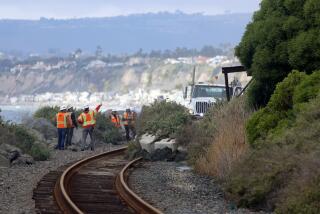Drive to Revive Rail Lines Gathers Steam : Three Northeast states say demand is growing. Train ridership is up nationwide.
- Share via
PORTLAND, Me. — More than 25 years after passenger train service linking Maine, New Hampshire and Massachusetts was abandoned, officials in the three New England states are giving serious thought to restoring it.
The discussion about reviving a dormant Portland, Me.-to-Boston train route is a response to growing demand for train service by residents in the expanding population areas of coastal Maine and southern New Hampshire, officials from those states said.
“We believe the time has come to pursue it,” Maine Transportation Secretary Dana Connors said.
Public transit advocates hope that such a line might be a first step in reviving passenger rail service throughout northern New England. The service was largely abandoned after the completion of much of the interstate highway system in the mid-1960s.
“A whole generation has forgotten the convenience of the steel highway,” said Wayne E. Davis, president of TrainRiders Northeast, a citizens’ advocate group with members in Maine, New Hampshire and northern Massachusetts that is promoting the railroad revival.
The movement in northern New England mirrors a national trend of renewed interest in passenger rail service, advocates say.
Amtrak, which operates the national intercity passenger rail network, set a record with 22.2 million riders in the 1990 fiscal year, up by nearly a million from the previous year, company spokesman Howard W. Robertson said. Amtrak has also set records in the last five years for the number of passenger miles logged; the fiscal 1990 total was 6.1 billion, a 3.7% increase over fiscal 1989.
Amtrak is studying the possible expansion of its system in several areas of the country, in addition to the Maine-to-Boston route. A new route linking New Orleans to Miami via Jacksonville, Fla., is being considered, as well as increased service between Los Angeles and San Diego and between Raleigh and Charlotte, N.C. It recently revived service in Wyoming.
The company is also in the midst of a project to shorten travel time for its Boston-to-New York trains.
Some state-run commuter rail systems also have seen significant growth in ridership. In Massachusetts, ridership doubled over the last nine years, and in Maryland, it doubled over five years.
The move to restore train service is not without costs. Commuter rail systems often require state or federal subsidies to supplement passenger revenues. Amtrak has estimated the annual cost of the Portland-to-Boston service at $5.4 million, of which $3.4 million in the first year would have to come from subsidies. Nationwide, 28% of Amtrak’s costs are subsidized.
But Ross Capon, director of the National Assn. of Railroad Passengers, said interest in rail transit is nevertheless increasing, fed by a recognition that the highway lobby had “gotten control of transportation policy in this country.”
“People (are) fed up with congested highways,” he said, also noting increased concerns with air pollution.
The effort to restore the Portland-to-Boston line was fueled by TrainRiders Northeast, which collected 60,000 signatures calling for Maine to seek funds to restore the line.
Last month, Maine lawmakers agreed to seek funding. Also, state officials sponsored two studies, one of which confirmed that demand is sufficient to justify restoring the Portland-to-Boston service. The other estimated the cost of restoration at $50 million.
State officials have estimated that up to 176,000 riders a year would travel along the 114-mile stretch between Portland and Boston.
If the Portland-to-Boston service is restored, Davis said, his group will push to revive other service, including to Augusta and Bangor, Me., and into Vermont and the Canadian provinces.
But advocates and officials concede that they face significant financial hurdles. With all three states involved bound by severe fiscal constraints, officials said, the project will require federal funds.
Davis said the investment in the restored service would be a sound one. “Our quality of life diminishes every day. This is one thing we can do to stave off some of the problems.”
More to Read
Sign up for Essential California
The most important California stories and recommendations in your inbox every morning.
You may occasionally receive promotional content from the Los Angeles Times.













